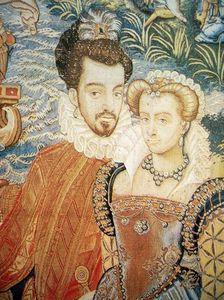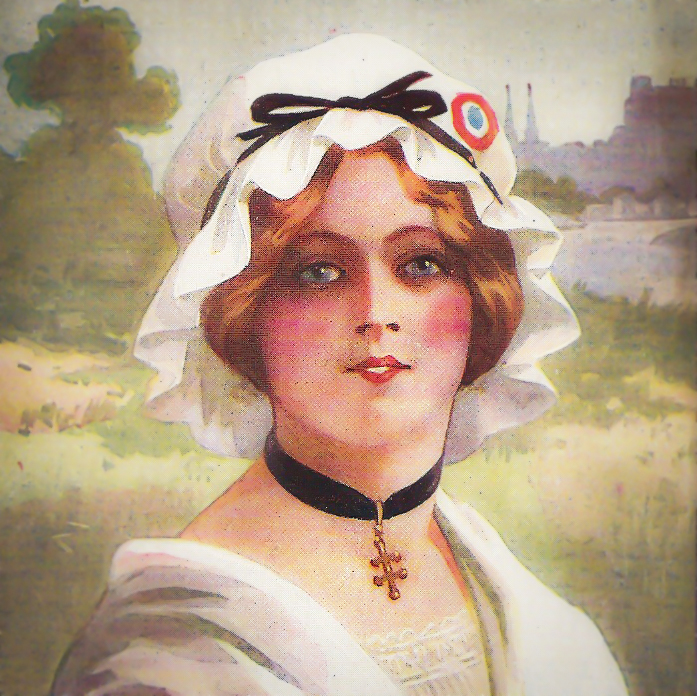En passant par la Lorraine is a classic of the French nursery rhymes. Who doesn't know its tune, with its clogs, its dondaine, its three captains and the famous "oh Oh OH"? But behind this joyful rhyme lies a whole story full of anecdotes. For sure, after reading these lines, you won't hear it in the same way anymore!

The story of the song
The song tells a rather peculiar story of a peasant girl who is mocked by noblemen.
The protagonists of the rhyme
After reading the lyrics of the nursery rhyme, it is clear that it does not exist to promote Lorraine as a destination to listeners. In any case, this is not its purpose.
Apart from the reference to the province in the first verse, the folk song involves three groups of characters: a young girl, three captains and a prince (the king's son).
The three captains
Let's start with the three companions. The nursery rhyme tells us nothing about them, but their rank of captain associates them with nobility. Are they knights of the Duke of Lorraine? Of the King of France? (I'll give you an answer later).
What the song tells us is that these messires are making fun of a young girl from Lorraine. A damsel whom they take for a wench:
"They called me: Vilaine!
With my clogs".
Today, the word "vilaine" is synonymous with "nasty", "unhealthy" or "bad". However, in the Middle Ages, the word "vilain" had a slightly different meaning: a peasant, a beggar, a villager, an ugly person. In clear contrast to the nobles, the refined elite of the city... who did not wear vulgar clogs!
The Vilaine from Lorraine
Let's linger for a moment on the story of this young girl with clogs.
Who is she?
Here too, the song does not tell us. But we have a few clues.
Thus, the story of the nursery rhyme curiously recalls the destiny of a virgin from Lorraine. Not Jeanne de Domrémy (aka Joan of Arc)... but a certain Louise de Nomeny.
Where is Nomeny?
Nomeny is today a small town of 1150 inhabitants located east of Pont-à-Mousson, halfway between Nancy and Metz.

Nomeny Ruined Castle
It looks like a small town... but if you knew its history, you would be surprised by its links with Henri III... the King of France himself!
Until 1548, Nomeny and its castle belonged to the bishops of Metz.
Nicolas de Lorraine (1524-1577), son of the Duke of Lorraine, Antoine le Bon, received the bishopric of Metz (1543) and then that of Verdun (1544) at a very young age. In 1548, he gave up his episcopal career and acquired the ban de Nomeny on his own account. The following year, he married Marguerite d'Egmont. Louise was born to them (30 April 1553 at the Château de Nomeny).
At the age of 10, the girl was placed in the Ducal Palace of Nancy, with her first cousin, Duke Charles III of Lorraine.

Ducal Palace of Nancy © French Moments
Cinderella's stepmother
Her father's third wife, Catherine de Lorraine-Aumale, proved to be an odious stepmother to Louise and her half-siblings. It is said that at the age of twenty, Louise was a great beauty: tall and slender, blonde with a white complexion... yes, that's right: a real Cinderella.

Louise de Lorraine
In the autumn of 1573, Henri, the brother of the King of France, was elected King of Poland. He left France en route to Krakow to take possession of his new kingdom. On his way through Lorraine, he stopped in Nancy where he was welcomed in the ducal palace by his brother-in-law (Duke Charles III of Lorraine, married to Henry's sister Claude of France).
It should be remembered that at that time the Duchy of Lorraine was an autonomous state within the Holy Roman Empire.
At Cinderella's ball
All the members of the Lorraine nobility were invited to the festivities given in honour of the new Polish sovereign. One of them was Louise, in her capacity as Princess of Vaudémont and cousin of the Duke of Lorraine.
Henry of France noticed Louise and found in her a certain resemblance to his then idyll, Marie de Clèves.
Henri's heart beat for Marie and he wanted so much to marry her. Bad luck, she was already married to Henri de Bourbon, Prince of Condé.
The king is dead, long live the king!
Less than a year later, King Charles IX of France died prematurely. Henri was recalled to France to succeed his brother... as Henri III of France.
A few months later, Marie de Cleves died in childbirth at the age of 21. The new king, who had so hoped to marry her, was inconsolable.
Matrimonial Matchmaker Ltd!
Queen Mother Catherine de Medici was determined to find an illustrious foreign princess to settle her son Henry once and for all. The latter absolutely had to marry to ensure the descent of the Valois dynasty.
Catherine was in some way in charge of Matrimonial Matchmaker Ltd. and intended to see her business through to the end.
But this was against the wishes of the young king, who played hard to get. He refused all the young girls presented to him. It was then that he remembered Louise, the one who looked so much like the Princess of Cleves. You remember, he had met her at the ball while passing through Lorraine!
I might as well tell you that the Queen Mother was not in a good mood when she heard this news... because Louise was of a very, very modest party for a king of France! A Vilaine one, that is!
The king's envoys
Against all odds, the king decided to marry the Vilaine girl and sent two officers to bring the lucky girl back to him. We even know the names of the king's two most trusted men: Philippe Hurault de Cheverny, his future chancellor, and Michel Du Guast, Marquis de Montgauger.
Ahh, when I told you it was a Cinderella story!
The Duke of Lorraine Charles III welcomed the messengers of the King of France in Nancy and asked one of his men to accompany them to Nomeny.
So the three men set off to find Louise in a small village lost in the Lorraine countryside... like three captains venturing outside the palace walls! In search of a wench in the countryside.
The nursery rhyme tells us that :
"Met three captains,
With my hooves.
They called me: Wench!
With my clogs".
This is a little historical shortcut. For the three captains in question went to Nomeny without meeting a young peasant girl on their way (not Louise anyway). We know that the girl was on pilgrimage to Saint-Nicolas-de-Port during the visit of the king's envoys... and it was Louise's father, Nicolas de Lorraine, who received them for lunch.
For a surprise, it is a surprise!
As you can guess, Louise's father did not wait for his daughter's return to ask her opinion. Honoured by the idea of becoming the father-in-law of the King of France, Nicolas gave his consent without hesitation.
Oh well, as goes the saying: les absents ont toujours tort ! (The absent are always in the wrong).
It was only on her return from her pilgrimage that Louise heard the news. And she even refused to believe it at first!
In fact, we don't really know what she really thought... either she was playing the rebellious teenager:
"Oh no!!! You're really a fool if you think I'm going to marry a stranger against my will!"
Or she was overjoyed:
"Oh, and I thought I was going to rot all my life in this godforsaken hole with these damn clogs! Farewell to Lorraine and can't wait to see PARIS!"
And we can imagine her singing another repertoire:
"Libérée, délivrééeeee!" (the French title song for Frozen's Let it go!)

Henri III and Louise de Lorraine
A royal wedding
Events followed one another. On 15 February 1575, the coronation of King Henry III of France and his marriage to Louise de Lorraine-Vaudémont were celebrated in Reims Cathedral. Yes, as long as you can kill two birds with one stone!
At the end of the month, they entered Paris together as lovers. Louise took up residence in the Louvre Palace. She was now Queen of France.
"Goodbye clogs, dondaines and mocking captains... I am now in Paris!"
If you are interested in Louise's story, read her bio on wikipedia.
And what about the 'Dondaines' in all this?
Well, we forgot to mention the Dondaines that punctuate the rhyme. What exactly is a dondaine?
An overweight lady?
A word created just for stylistic effect?
A synonym for "Say so"?
It is simply a projectile fired by crossbows in the Middle Ages. The dondaine (or dondon) was reserved for military use and was shaped like a fat woman... well, a sort of dindon dodu!
Vous n'aurez pas l'Alsace et la Lorraine!
As we have said, the melody was forgotten... until the end of the 19th century.
Let us now open our history books.
The Franco-Prussian war of 1870-71 ended in defeat for France. In the Treaty of Frankfurt, the Prussian chancellor Bismarck obtained Alsace and the Lorraine department of Moselle.
Faced with this affront, the young Third Republic of France did not fail to inspire the French to take revenge. Alsace-Lorraine was never to be forgotten.
And what better way than to prepare the minds of children... those who would later become the soldiers that France would need to recover the lost provinces!

Lorraine girl wearing the Cross of Lorraine around her neck
From Brittany to Lorraine
An original Breton melody (M’en revenant de Rennes) was given a new life, a refrain was added (les sabots, dondaine) and the whole thing was given a military soundtrack.
This is how popular songs such as En passant par la Lorraine helped prepare children for war... in a discreet way of course!
That's it, vous n'aurez pas l'Alsace et la Lorraine! (You won't get Alsace and Lorraine!)
The song goes on...
The return of Alsace-Lorraine to France did not mean the end of the story.
En Passant par la Lorraine remained a popular nursery rhyme, performed many times (do a search on YouTube to find out!)
The rhyme influenced Georges Brassens to write Les sabots d'Hélène :
En passant par la Lorraine
Lyrics, music, free download... let's learn more about the popular song:

The lyrics in French
The original song of En passant par la Lorraine has 6 verses. The French often only remember the lyrics of the first verse...
Couplet 1
En passant par la Lorraine, avec mes sabots. (bis)
Rencontrai trois capitaines,
Avec mes sabots, dondaine,
Oh ! Oh ! OH ! Avec mes sabots.
Couplet 2
Rencontrai trois capitaines, avec mes sabots. (bis)
Ils m’ont appelée : Vilaine !
Avec mes sabots, dondaine,
Oh ! Oh ! OH ! Avec mes sabots.
Couplet 3
Ils m’ont appelée : Vilaine ! avec mes sabots. (bis)
Je ne suis pas si vilaine,
Avec mes sabots, dondaine,
Oh ! Oh ! OH ! Avec mes sabots.
Couplet 4
Puisque le fils du roi m’aime, avec mes sabots. (bis)
Il m’a donné pour étrenne,
Avec mes sabots, dondaine,
Oh ! Oh ! OH ! Avec mes sabots.
Couplet 5
Un bouquet de marjolaine, avec mes sabots. (bis)
Je l’ai planté sur la plaine,
Avec mes sabots, dondaine,
Oh ! Oh ! OH ! Avec mes sabots.
Couplet 6
S’il fleurit, je serai reine, avec mes sabots. (bis)
S’il y meurt, je perds ma peine,
Avec mes sabots, dondaine,
Oh ! Oh ! OH ! Avec mes sabots.
Translation of the lyrics into English
Here is an approximative translation into English:
Verse 1
Passing through Lorraine, with my clogs (bis)
Met three captains,
With my clogs, dondaine,
Oh! Oh! OH! With my clogs.
Verse 2
I met three captains, with my clogs ( bis)
They called me: Naughty!
With my clogs, dondaine,
Oh! Oh! OH! With my clogs.
Verse 3
They called me: Ugly! with my clogs ( bis)
I am not so naughty,
With my clogs, dondaine,
Oh! Oh! OH! With my clogs.
Verse 4
Since the king's son loves me, with my clogs ( bis)
He gave me for a gift,
With my clogs, dondaine,
Oh! Oh! OH! With my clogs.
Verse 5
A bunch of marjoram, with my clogs (bis)
I planted it on the plain,
With my clogs, dondaine,
Oh! Oh! Oh! With my clogs.
Verse 6
If it blooms, I'll be queen, with my clogs (bis)
If it dies, I lose my pain,
With my clogs, dondaine,
Oh! Oh! OH! With my clogs.
- Read this article in French on our blog Mon Grand-Est
- Discover the region of Lorraine!


